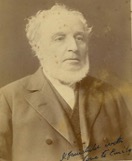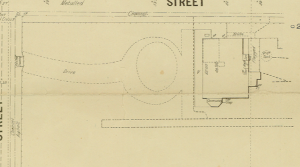Collingwood Notables Database
Jesse Fairchild
1815 - 1901
Fellmonger, early settler, subdivider
Jesse Fairchild lived and worked by the banks of the Yarra in Abbotsford. He arrived in Port Phillip in January 1842. Having been a fellmonger in St James Deeping in Lincolnshire, he first acquired a sheep station. However, falling prices sent him to employment at a fellmongers in Melbourne, where he eventually acquired his own business. As the town expanded, such industries could no longer be accommodated in the central area, and Fairchild moved operations to Abbotsford.
The land he acquired in Abbotsford was around 14 acres, the western half of Crown Portion 60, bounded by Church Street and Victoria Street. We know he had established the fellmongering trade there at least by 1851, and soon he became an active local resident. In 1853 he was one of a group of inhabitants, including Robert Fennell and Peter Nettleton, who raised money and applied for a Central Road Board grant for improvements to the nearly impassible Simpson’s Road, as Victoria Street was then called. He was also on the committee of the Studley Park Bridge Company which built a toll bridge to cross the Yarra at the end of Church Street and remained a shareholder until 1899.
In 1856 he was advertising his property to let as he planned to spend several years in England. Even allowing for estate agent’s hyperbole, this description below can attest to his success. What is not mentioned is the water and air pollution caused by such noxious industries as his, and those belonging to Nettleton, Richard Goldsbrough and Frederick Row. These men were regarded as valued Collingwood citizens, whose works were ‘beneficial to the district’. But they did at least, in the typical nineteenth-century pattern, live next to their works.
on the Yarra, fronting the continuation of Victoria-parade, or Simpson's-road, with excellent Country Residence … The well-known Woolthorpe Fellmongery Establishment, with stores, drying sheds and yards, sorting and dressing houses, tainting and stripping houses, washing stages, baskets and sheds, scouring coppers, stables for eight horses, and various other buildings, forming in every respect the most complete premises in any of the colonies for this business, and fully equal to the getting-up of 6,000 full fleeced skins per week. … fourteen Acres of Land, on a portion of which is erected a most complete Bluestone Country Residence, containing drawing-room, dining room, butler's pantry and store-rooms, four bedrooms, servants' kitchen about 30 feet square, with various other rooms and outbuildings. The House is beautifully situated on the banks of the river facing the Studley Park reserve, is surrounded by ornamental garden and grounds containing the choicest flowers and shrubs, and … may be compared with the most finished residence in the colony. There is a fruit plantation of about one acre, and a portion of the land under crop … the lessee will at once enter upon a most lucrative business, combined with one of the best residences near Melbourne. (The Argus 27 September 1856)
In 1849 Fairchild had married Mary, a widow with a young son called James, who would attend school in England during the family’s 1857 – 1858 sojourn. Mary’s background proved rather difficult for family historians to unravel. She was certainly transported to Tasmania as a convict, but her age, her name and that of her rumoured husband vary from one document to another. She is believed to have been Fairchild’s housekeeper before he proposed marriage. The couple produced no children of their own but James, his stepson who took the surname Fairchild, eventually married Emma Australia Staughton in 1868 and would produce a large batch of grandchildren.
In December 1863 the premises were again offered to let, with or without the dwelling, which by now was called Yarra House. The fellmongery was let to tanner James Hobson Turner, later to become owner of the Denton Hat Mills in Nicholson Street and serve on Collingwood Council for fifteen years.
In July 1864 Fairchild was again contemplating a return to England and his household furniture was advertised for sale at Yarra House. As well as the usual range of furniture, there were two ‘brilliantly-toned’ pianos, an organ ‘suitable for a small church’, carriages and horses.
By the late 1860s the Fairchilds had moved to 35 Dalgety Street St Kilda and named their new residence Yarra House. James and Emma Fairchild and their older children moved into the Abbotsford Yarra House by 1872 and the rest of their children were born there. Jesse and James continued to operate a woolwashing works on the Yarra banks in South Melbourne.
In 1885 Fairchild’s landholding was subdivided into building lots and was auctioned as the Fairchild Estate. Among the new streets created were Bent, Fairchild and Cooke Streets (Cooke was Jesse’s mother’s maiden name; Sir Thomas Bent, a politician and land speculator of somewhat questionable reputation, had acquired an interest in the estate); Jesse was to retain ownership of some sites in Victoria Street until his death in 1901.
The Abbotsford Yarra House, which originally had a long drive from Church Street, remained on a sizeable piece of land, about three-quarters of an acre, but its address was now Fairchild Street on the corner of Bent Street. James moved into Tolarno in Fitzroy Street, St Kilda after Yarra House was bought by boot manufacturer Robert Hurst whose family lived there for nearly thirty years. After his widow’s death it was acquired by Carlton and United Breweries and used as a grain store, and the site including Bent Street eventually disappeared under the massive CUB complex.
Jesse is memorialised by a drinking fountain in St Kilda, a cottage in the Old Colonists homes in North Fitzroy, and by the streets named after him and his mother, where the brick terrace houses built just after the land subdivision are described by estate agents nowadays, in wording reminiscent of their nineteenth century counterparts, as ‘Enviably positioned within moments of the Yarra River, with easy access to the CBD’ and in a ‘prized riverside pocket’.
Yarra House with driveway, garden and conservatory ca. 1900
Life Summary
| Birth Date | Birth Place |
|---|---|
| 15 March 1815 | Deeping St James, Lincolnshire, England |
| Spouse Name | Date of Marriage | Children |
|---|---|---|
| Mary Ann Farrar | 21 July 1849, St James Cathedral | Stepson James Robert Farrar Fairchild, 1845 - 1887 |
| Home Street | Home City | Status of Building |
|---|---|---|
| Church Street | Abbotsford | Demolished |
| Work Street | Work City | Status of Building |
|---|---|---|
| Church Street | Abbotsford | Demolished |
| Church | Lodge |
|---|---|
| Church of England |
| Death Date | Death Place | Cemetery |
|---|---|---|
| 5 August 1901 | St Kilda, Victoria | Boroondara |
The Melbourne Courier; The Argus; The Sydney Morning Herald; The Age; Weekly Times; Leader; The Australasian; Mercury and Weekly Courier; The Prahran Telegraph.
Trove list “Jesse Fairchild” https://trove.nla.gov.au/list/90224
Barrett, The inner suburbs
Cummings, Streets Parks and Lanes of Collingwood


